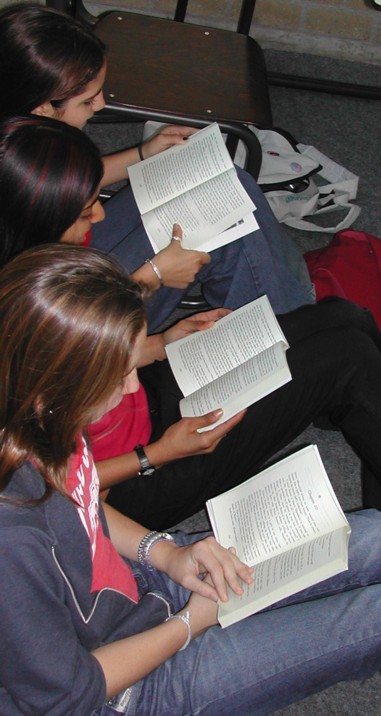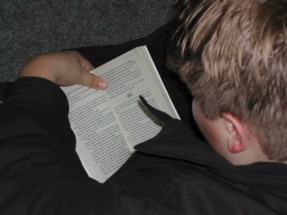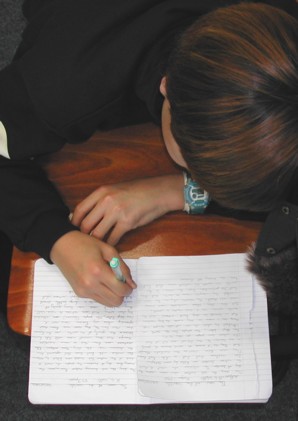Note: Since 2003, when I wrote this article, I’ve moved from paper to digital journals and book-rating sheets, but the principles remain unchanged.
Teachers often
lament that students don’t read enough, and that as a result
their skills are weak, their literary experience thin, their
general background knowledge deficient. Despite this, English
classes in secondary schools usually require students to read
only a few works each year. In subjects other than English, students
often read even less.
My early attempts to recommend
good books and encourage reading failed: the readers
kept reading, the non-readers ignored me. Embracing, therefore,
the logic of the school--students work in return for marks--I
began to require what I called “outside reading”, and to
count it as a substantive portion of the final grade. Over the
past two decades I have continued the practice in a wide variety
of schools on three continents. Results? Non-readers and
reluctant readers begin to read, and to discover books that they
enjoy. The non-reading high-achievers--those who want A’s, but
will read a book only “if it counts”--begin to acquire the background
they will need to compete for high marks in the upper grades and
at university. And non-anglophones accelerate their progress toward
full fluency.
The programme I’ve developed is simple
for students and teachers, and easy to adapt for special
purposes, or for subjects other than English. Here’s how
it works.
•Students choose their own books, with my approval, and earn marks according to the number of pages they read.
Thus, differentiation is built-in, and all students can succeed, since 150 pages of a “Goosebumps” novel earns the same credit as 150 pages of Tolstoy (of course, those who consistently choose more challenging books are given a break if their page totals are a bit lower). Moreover, fast readers aren’t held back by their classmates, and slow readers don’t fall behind, as is so often the case with books studied by the whole class.

Eric MacKnight has taught English in the United States, North Africa, Switzerland, Austria, Canada, and Holland. He currently teaches at Suzhou Singapore International School in Suzhou, China.

At first, I allow students almost total freedom to choose books--I require only that they read fiction. If I see students making poor choices, I step in. Some will choose books that are too difficult. Others get stuck in ruts: fantasy novels (boys) and romances (girls) are the most common. I offer whatever advice is needed to keep them reading, and growing.
Journals
•For each book they complete, students write a journal entry.
For journals, I require staple-bound A5 or 6" x 9" exercise books, which are the right size, lie flat for easy stacking, and are easily distinguished from the full-sized binders and exercise books that students use for other purposes. Each entry is three pages long.
For younger students, Page 1 is a plot summary, Page 2 a description of one of the main characters, and Page 3 a personal response to the novel. Older students use Page 1 to describe a character or theme; Page 2 to discuss the author’s tone, or style and technique; and Page 3 for a personal response.
Journal entries help me gauge students’ understanding of their reading. The topics--plot, character, theme, tone, style, personal response--give students experience writing in the most common modes of literary analysis. I don’t usually mark writing errors in these journal entries, because I want students to write them freely and quickly--they shouldn’t pose a barrier to doing the reading.
Daily Reading
•Students should read every day, seven days a week.
Why? First, I want them to develop the habit of reading. Second, if they don’t read every day, they will procrastinate and fall behind.
How long should they read each day? I ask for fifteen minutes, and using a bit of reverse psychology, I urge them not to read for more than fifteen minutes a day, outside of class. I design my grading scale so that even a very slow reader, if she reads for fifteen minutes every day, can earn a C+ (say, 75 pages per week; vary the scale as needed). Students see very quickly that this is a good deal for them. Many, of course, exceed my 15-minute “limit”, as I hope they will.
In-Class Reading
•I give (most) students regular time to read in class.
For younger students (11-14), one class a week seems about right. For older students, in-class reading days can be more occasional; for very able, motivated students, in-class reading time can be omitted.
Book-Rating Sheets
•Students list the books they have read on a “book-rating sheet”.
For each book, students record the author, title, and number of pages. They also rate the book’s difficulty (1-4), and how much they enjoyed it (1-10). Each student has his or her own rating sheet, and updates it periodically. I keep the sheets in the classroom so they won’t go missing. The rating sheets give students a great feeling of accomplishment. As the year progresses, many are astonished--and very proud--to see how many books they have read.

The rating sheets also help me discover which books are most popular. Every term or so I will look through them in class and ask students to talk about books they have given a “9” or “10”. Inspired by these descriptions, other students try the books their peers have enjoyed, and gradually a kind of “reading community” develops.
In teaching, it’s not really what we do that counts--it’s what the students do. Our job is to inspire them, give them the tools they need, and then get out of their way.
Students need not be so limited in their reading skills and experience. Teachers who experience the benefits of giving students the opportunity to read widely will become believers, as I am, in the value of a structured independent reading program.
This article was first published in a slightly different version in the official magazine of the European Council of International Schools, "International Schools" (Winter/Summer 2003, Volume 5, Issue 3).
For more on Independent Reading and downloadable copies of my introductory handouts and book-rating sheet, visit my blog at EricMacKnight.com.
Thanks to the students of IS2a (2002-03) at the International Secondary School Eindhoven, and especially to Chrissie, Gauri, Eliran, Kanan, and Michael.
Teachers: You are welcome to make copies of this article. (Use the printer friendly version.) If you give my system a try, I'd love to hear how it goes. --Eric